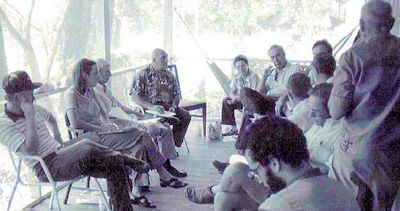WILMINGTON — In 1982, as the newly formed N.C. Coastal Federation helped residents fight proposed peat mining on the Albemarle/Pamlico peninsula, its leaders recognized that their fledgling organization was likely to have staying power.
“It was our hope and dream that it would be an ongoing proposition,” says Executive Director Todd Miller, the only employee at the time.
Supporter Spotlight
So, in an era before widespread email and computer use, “We kept paper files on things we were working on,” he says.
In the years since, as membership grew to more than 10,000 and preservation efforts spread to include all 20 coastal counties, the organization continued to detail everything from studies that its staff, which now numbers 22, consulted to papers they filed in defense of federation positions.

Newspaper clippings on anything coastal were filed away, as were issues of the federation newsletters, Coastal Review. Even the sums brought in by T-shirt sales were duly recorded.
Now, what were 15 to 20 filing cabinets filled with papers representing the years 1982 through 2004 have been transferred to the Special Collections unit of the Randall Library at the University of North Carolina at Wilmington.
There, Special Collections Coordinator Jerry Parnell and his staff, after organizing the files and preparing an online index, have made them available to the public.
Supporter Spotlight
“The records,” says the library, “chronicle the transformation of the North Carolina Coastal Federation from a small group concerned with coastal issues to an active, influential participant in North Carolina coastal management.”
Though Parnell expects university faculty and students to consult the files, Miller thinks the federation itself may be among the biggest beneficiaries.
In its role of environmental advocate, the federation has been a source of practical and scientific information for policymakers dealing with coastal issues, he says. And the same issues, like stormwater pollution of coastal waters, crop up repeatedly, he says.
“As we cycle through new administrations and leadership in the state, the same questions get asked again and again.”
Instead of having to rely solely on memory, federation officials can consult the archived documents, he says, to understand how they arrived at a particular position.
“We’ve learned a lot from past efforts, evolved strategies that are based on . . . what practically will work,” Miller said. “You don’t have to reinvent the wheel.”
One example, he says, is the recurring debate about how best to control stormwater runoff. In other parts of the state where shellfish beds don’t have to be protected, a good bit of attention is paid to controlling the pollutant-heavy “first flush” of runoff, he says.
But because coastal waters need the protection from bacteria that longer-lasting control can provide, Miller says, “We’ve taken a different path . . . with good reasons to do that, good, valid, scientific reasons.”
Taken as a whole, the papers provide an overview of the life of the coast 1982-2004.
Fifty-two oral interviews by historian J. Glenn Blackburn, long-time federation member, author and retired professor at the University of Virginia’s College at Wise, Va., flesh out the facts with the human story behind them.

He talks to Anne and Wayne Brady, crabbers in the Albemarle/Pamlico area who feared for their livelihoods when the proposed peat mining operation threatened in 1982-83. The idea was dropped when a federal subsidy ran out, but not before the newly formed federation played a major role in fighting it.
Blackburn also interviews James Barrie Gaskill, a commercial fisherman whose family has been on Ocracoke Island since the 18th century.
Gaskill, a federation board member since 1993, says that fishermen’s dislike for governmental fish-catch quotas and other environmental regulations make them wary of environmental organizations in general.
But the federation, he says, has a better reputation than many because “We aren’t against everything . . . We are there to help people.”
And ocean ecologist Richard Barber of Beaufort, professor emeritus at the Duke Marine Lab in Beaufort and former member of the N.C. Environmental Management Commission, describes the federation as being like a family company, based on friendships and dedication to a place.
Its greatest contribution, he says, has been helping to sustain the coast, which he sees as still beautiful and a good place to live.
Blackburn “has done a wonderful job of reaching out to all the people involved with the federation from the beginning, and getting their perspectives on what we’ve been able to accomplish together,” Miller says.
The historian, who is writing a history of the federation (Working title: “We Love the Coast: The Story of the North Carolina Coastal Federation”) was the go-between for the federation and UNCW.
Parnell made three trips to federation headquarters in Ocean in the summer of 2008 to pick up the papers.
The three van loads were “a little bit more than I expected,” he says.
Even more materials will be turned over in the future, including more interviews by Blackburn, and Parnell and his staff expect to organize, conserve and present them as well.
“It’s a wonderful service by UNCW,” says Miller.
Finding the Archives
To find the federation papers, go online.
Search for N.C. Coastal Federation, bringing up a Records and Manuscripts line. Click it, and under “Special Collections – Manuscript Finding Aids,” click on “North Carolina Coastal Federation Papers SC/MS/313.”
In its “detailed description,” the finding aid lists material under six major headings, or “series:” administrative records, subject files, newspaper clippings, publications including the Coastal Review, maps and Blackburn’s oral history abstracts.
Blackburn’s oral histories can be read online in pdf format. To see the other documents, record the identifying numbers of the folders and the boxes they’re stored in and take the information to UNCW’s Randall Library, 601 S. College Rd. in Wilmington.
To make an appointment, which Parnell says is the fastest, most efficient way to view the papers, email him or Rebecca Baugnon. Special Collections is on the library’s second floor, Room 2042. It’s open 9 a.m. to 5 p.m. Mondays-Thursdays and 9 a.m. to noon Fridays on days when classes are in session.
If you’re looking for information on a particular topic, the “subject files” series is divided into 42 sub-series with general titles like “Water Quality.”
If you’re searching for a more specific topic, like information on “Shell Fishing and Water Quality, 1982-1991,” a numbered folder with that name will be stored in a numbered box under the general “Water Quality”sub-series heading.







